The Egyptian pyramids of the Giza Necropolis, as seen from the airPerhaps the world’s most popular pyramid is the Great Pyramid of Giza, a pyramid built in the ancient time as burial place for King Khufu.
It is one of the grandest structures of ancient period and was regarded as one of the “Seven Wonders of the World”. As a matter of fact, it is the only surviving wonder of the ancient world.
A
pyramid (from
Greek:
"πυραμίς" – pyramis]) is a
structure whose outer surfaces are roughly triangular and converge to a single point at the top. The base of a pyramid can be trilateral, quadrilateral, or any polygon shape, meaning that a pyramid has at least three triangular surfaces (at least four
faces including the base). The
square pyramid, with square base and four triangular outer surfaces, is a common version.
A pyramid's design, with the majority of the weight closer to the ground, and with the
pyramidion on top means that less material higher up on the pyramid will be pushing down from above. This distribution of weight allowed early civilizations to create stable monumental structures.
Pyramids have been built by civilizations in many parts of the world. For thousands of years, the
largest structures on Earth were pyramids—first the
Red Pyramid in the
Dashur Necropolis and then the
Great Pyramid of
Khufu, both of
Egypt, the latter the only one of the
Seven Wonders of the Ancient World still remaining. Khufu's Pyramid is built entirely of
limestone, and is considered an architectural masterpiece. It contains around 1,300,000 blocks ranging in weight from 2.5 tonnes (5,500 lb) to 15 tonnes (33,000 lb) and is built on a square base with sides measuring about 230 m (755 ft), covering 13 acres. Its four sides face the four cardinal points precisely and it has an angle of 52 degrees. The original height of the Pyramid was 146.5 m (488 ft), but today it is only 137 m (455 ft) high, the 9 m (33 ft) that is missing is due to the theft of the fine quality limestone covering, or casing stones to build houses and Mosques in Cairo. It is still the tallest pyramid.
The
Great Pyramid of Cholula, also known as
Tlachihualtepetl (
Nahuatl for "artificial mountain"), is a huge complex located in
Cholula,
Puebla,
Mexico. It is the largest archaeological site of a pyramid (temple) in the
New World.
The
pyramid stands 55 metres (180 ft) above the surrounding plain,
and in its final form it measured 400 by 400 metres (1,300 by 1,300 ft).
The pyramid is a temple that has traditionally been viewed as having been dedicated to the god
Quetzalcoatl.
The
architectural style of the building was closely linked to that of
Teotihuacan in the
Valley of Mexico, although influence from the
Gulf Coast is also evident, especially from
El Tajín.


View of the Avenue of the Dead and the
Pyramid of the Sun, from the
Pyramid of the MoonAncient monumentsMesopotamia
The
Mesopotamians built the earliest pyramidal structures, called
ziggurats. In ancient times, these were brightly painted. Since they were constructed of sun-dried mud-brick, little remains of them. Ziggurats were built by the
Sumerians,
Babylonians,
Elamites,
Akkadians, and
Assyrians for local religions. Each ziggurat was part of a temple complex which included other buildings. The precursors of the ziggurat were raised platforms that date from the
Ubaid period during the fourth
millennium BC. The earliest ziggurats began near the end of the
Early Dynastic Period. The latest Mesopotamian ziggurats date from the 6th century BC. Built in receding tiers upon a rectangular, oval, or square platform, the ziggurat was a pyramidal structure with a flat top. Sun-baked
bricks made up the core of the ziggurat with facings of fired bricks on the outside. The facings were often glazed in different colors and may have had
astrological significance. Kings sometimes had their names engraved on these glazed bricks. The number of tiers ranged from two to seven. It is assumed that they had shrines at the top, but there is no archaeological evidence for this and the only textual evidence is from
Herodotus.
Access to the shrine would have been by a series of ramps on one side of the ziggurat or by a spiral ramp from base to summit. The Mesopotamian ziggurats were not places for public worship or ceremonies. They were believed to be dwelling places for the
gods and each city had its own patron god. Only priests were permitted on the ziggurat or in the rooms at its base, and it was their responsibility to care for the gods and attend to their needs. The priests were very powerful members of
Sumerian society.
Choga Zambil
Choga Zambil means 'basket mound.'
It was built
about 1250 BC by the king
Untash-Napirisha, mainly to honor the great god
Inshushinak. Its original name was
Dur Untash, which means 'town of Untash', but it is unlikely that many people, besides priests and servants, ever lived there. The complex is protected by three concentric walls which define the main areas of the 'town'. The inner area is wholly taken up with a great ziggurat dedicated to the main god, which was built over an earlier square temple with storage rooms also built by Untash-Napirisha.
The middle area holds eleven temples for lesser gods. It is believed that twenty-two temples were originally planned, but the king died before they could be finished, and his successors discontinued the building work. In the outer area are royal palaces, a funerary palace containing five
subterranean royal tombs.
Although construction in the city abruptly ended after Untash-Napirisha's death, the site was not abandoned, but continued to be occupied until it was destroyed by the
Assyrian king
Ashurbanipal in 640 BC. Some scholars speculate, based on the large number of temples and sanctuaries at Chogha Zanbil, that Untash-Napirisha attempted to create a new religious center (possibly intended to replace
Susa) which would unite the gods of both highland and lowland Elam at one site.
The ziggurat is considered to be the best preserved example in the world. In 1979, Chogha Zanbil became the first Iranian site to be inscribed on the
UNESCO World Heritage List.
Egypt
The most famous pyramids are the
Egyptian pyramids — huge structures built of brick or stone, some of which are among the world's largest constructions. The age of the pyramids reached its zenith at Giza in 2575-2150 B.C.
As of 2008, some 135 pyramids have been discovered in Egypt.
The
Great Pyramid of Giza is the largest in Egypt and one of the largest in the world. Until
Lincoln Cathedral was finished in AD 1311, it was the tallest building in the world. The base is over 52,600
square metres in area. While pyramids are associated with Egypt, the nation of Sudan has 220 extant pyramids, the most numerous in the world.
The Great Pyramid of Giza is one of the
Seven Wonders of the Ancient World. It is the only one to survive into modern times. The Ancient Egyptians covered the faces of pyramids with polished white
limestone, containing great quantities of fossilized seashells.
Many of the facing stones have fallen or have been removed and used to build the
mosques of
Cairo.
Most pyramids are located near Cairo, with only one royal pyramid being located south of Cairo, at the Abydos temple complex. The pyramid at
Abydos, Egypt were commissioned by
Ahmose I who founded the
18th Dynasty and the
New Kingdom.
The building of pyramids began in the
3rd Dynasty with the reign of King
Djoser. Early kings such as
Snefru built several pyramids, with subsequent kings adding to the number of pyramids until the end of the Middle Kingdom. The last king to build royal pyramids was Ahmose, with later kings, afraid of looting, deciding to hide their tombs in the hills, like in the
Valley of the Kings in Luxor's West Bank.
In Medinat Habu, or
Deir el-Medina, smaller pyramids were built by individuals. Smaller pyramids were also built by the Nubians who ruled Egypt in the Late Period, though their pyramids had steeper sides.
Sudan
Nubian pyramids were constructed (roughly 220 of them) at three sites in Sudan to serve as tombs for the kings and queens of
Napata and
Meroë. The pyramids of Kush, also known as Nubian Pyramids, have different characteristics than the pyramids of Egypt. The
Nubian pyramids were constructed at a steeper angle than Egyptian ones. They were monuments to dead kings and queens.
Pyramids were still being built in Sudan as late as AD 300.
Nigeria
''The Nsude pyramids in 1935. These ten circular stepped pyramids were associated with the Uto deity and were made of mud.
One of the unique structures of
Igbo culture was the
Nsude Pyramids, at the Nigerian town of Nsude, in Abaja, northern Igboland. Ten pyramidal structures were built of clay/mud. The first base section was 60 ft. in circumference and 3 ft. in height. The next stack was 45 ft. in circumference. Circular stacks continued, till it reached the top. The structures were temples for the god
Ala/
Uto, who was believed to reside at the top. A stick was placed at the top to represent the god's residence. The structures were laid in groups of five parallel to each other. Because it was built of clay/mud like the Deffufa of Nubia, time has taken its toll requiring periodic reconstruction.
Greece
Pausanias (2nd century AD) mentions two buildings resembling pyramids, one, twelve miles southwest of the still standing structure at Hellenikon, a common tomb for soldiers who died in a legendary struggle for the throne of
Argos and another which he was told was the tomb of Argives killed in a battle around 669/8 BC. Neither of these still survive and there is no evidence that they resembled Egyptian pyramids.
There are also at least two surviving pyramid-like structures still available to study, one at
Hellenikon and the other at Ligourio/Ligurio, a village near the ancient theatre Epidaurus. These buildings were not constructed in the same manner as the pyramids in Egypt. They do have inwardly sloping walls but other than those there is no obvious resemblance to Egyptian pyramids. They had large central rooms (unlike Egyptian pyramids) and the Hellenikon structure is rectangular rather than square, 12.5 metres by 14 metres which means that the sides could not have met at a point. The stone used to build the pyramids was limestone quarried locally and was cut to fit, not into freestanding blocks like the
Great Pyramid of Giza.
There are no remains or graves in or near the structures. Instead, the rooms that the walls housed were made to be locked from the inside. This coupled with the platform roof, means that one of the functions these structures could have served was as watchtowers. Another possibility for the buildings is that they are shrines to heroes and soldiers of ancient times, but the lock on the inside makes no sense for such a purpose.
The dating of these ‘pyramids’ has been made from the pot shards excavated from the floor and on the grounds. The latest dates available from scientific dating have been estimated around the 5th and 4th centuries. Normally this technique is used for dating
pottery, but here researchers have used it to try to date stone flakes from the walls of the structures. This has created some debate about whether or not these ‘pyramids’ are actually older than
Egypt, which is part of the
Black Athena controversy. The basis for their use of thermoluminescence in order to date these structures is a new method of collecting samples for testing. Scientists from laboratories hired out by the recent excavators of the site, The
Academy of Athens, say that they can use the electrons trapped on the inner surface of the stones to positively identify the date that the stones were quarried and put together.
Mary Lefkowitz has criticised this research. She suggests that some of the research was done not to determine the reliability of the dating method, as was suggested, but to back up an assumption of age and to make certain points about pyramids and Greek civilization. She notes that not only are the results not very precise, but that other structures mentioned in the research are not in fact pyramids, e.g. a tomb alleged to be the tomb of Amphion and Zethus near Thebes, a structure at Stylidha (Thessaly) which is just a long wall, etc. She also notes the possibility that the stones that were dated might have been recycled from earlier constructions. She also notes that earlier research from the 1930s, confirmed in the 1980s by Fracchia was ignored. She argues that they undertook their research using a novel and previously untested methodology in order to confirm a predetermined theory about the age of these structures.
Liritzis responded in a journal article published in 2011, stating that Lefkowitz failed to understand and misinterpreted the methodology.
Spain
The
Pyramids of Güímar refer to six rectangular pyramid-shaped, terraced structures, built from lava stone without the use of
mortar. They are located in the district of Chacona, part of the town of
Güímar on the island of
Tenerife in the
Canary Islands. The structures have been dated to the 19th century and their original function explained as a byproduct of contemporary
agricultural techniques.
Local traditions as well as surviving images indicate that similar structures (also known as, "Morras", "Majanos", "Molleros", or "Paredones") could once have been found in many locations on the island. However, over time they have been dismantled and used as a cheap building material. In Güímar itself there were nine pyramids, only six of which survive.
China
There are many square
flat-topped mound tombs in China. The First Emperor
Qin Shi Huang (circa 221 BC, who unified the 7 pre-Imperial Kingdoms) was buried under a large mound outside modern day
Xi'an. In the following centuries about a dozen more
Han Dynasty royals were also buried under
flat-topped pyramidal earthworks.
Mesoamerica
A number of
Mesoamerican cultures also built pyramid-shaped structures.
Mesoamerican pyramids were usually stepped, with temples on top, more similar to the Mesopotamian ziggurat than the Egyptian pyramid.
The largest pyramid by volume is the
Great Pyramid of Cholula, in the
Mexican state of
Puebla. This pyramid is considered the largest monument ever constructed anywhere in the world, and is still being excavated. The third largest pyramid in the world, the
Pyramid of the Sun, at
Teotihuacan is also located in
Mexico. There is an unusual pyramid with a circular plan at the site of
Cuicuilco, now inside
Mexico City and mostly covered with lava from an eruption of the
Xitle Volcano in the first century BC. There are several circular stepped pyramids called
Guachimontones in Teuchitlán,
Jalisco as well.
Pyramids in Mexico were often used as places of
human sacrifice. For the re-consecration of
Great Pyramid of Tenochtitlan in 1487, the Aztecs reported that they sacrificed about 80,400 people over the course of four days.
Peru

Caral was a large settlement in the Supe Valley, near Supe, Barranca province, Peru, some 200 km north of Lima. Caral is the most ancient city of the Americas, and is a well-studied site of the Caral civilization or Norte Chico civilization. Caral was inhabited between roughly 2600 BCE and 2000 BCE,nclosing an area of more than 60 hectares. Caral was described by its excavators as the oldest urban center in the Americas, a claim that was later challenged as other ancient sites were found nearby. Accommodating more than 3,000 inhabitants, it is the best studied and one of the largest Norte Chico sites known.
- Paul Kosok discovered Caral in 1948, but it received little attention until recently because it appeared to lack many typical artifacts that were sought at archeological sites throughout the Andes at the time. Archaeologist Ruth Shady further explored the 5,000 year-old city of pyramids in the Peruvian desert, with its elaborate complex of temples, an amphitheater and ordinary houses. The urban complex is spread out over 150 acres (607,000 m²) and contains plazas and residential buildings. Caral was a thriving metropolis at roughly the same time that Egypt's great pyramids were being built.
North America
Many pre-Columbian Native American societies of ancient North America built large pyramidal earth structures known as platform mounds. Among the largest and best-known of these structures is Monks Mound at the site of Cahokia, which has a base larger than that of the Great Pyramid at Giza. Many of the mounds underwent multiple episodes of mound construction at periodic intervals, some becoming quite large. They are believed to have played a central role in the mound-building peoples' religious life and documented uses include semi-public chief's house platforms, public temple platforms, mortuary platforms, charnel house platforms, earth lodge/town house platforms, residence platforms, square ground and rotunda platforms, and dance platforms.Cultures who built substructure mounds include the Troyville culture, Coles Creek culture, Plaquemine culture and Mississippian cultures.
Roman Empire
The 27-metre-high
Pyramid of Cestius was built by the end of the first century BC and still exists today, close to the
Porta San Paolo. Another one, named
Meta Romuli, standing in the
Ager Vaticanus (today's
Borgo), was destroyed at the end of the 15th century.
There is also a Roman era
pyramid built in
Falicon, France. There were many more pyramids built in France in this period.
Medieval Europe
Pyramids have occasionally been used in Christian architecture of the feudal era, e.g. as the tower of
Oviedo's Gothic
Cathedral of San Salvador.
India

Many giant
granite temple pyramids were made in
South India during the
Chola Empire, many of which are still in religious use today. Examples of such pyramid temples include
Brihadisvara Temple at
Thanjavur, the
Temple of Gangaikondacholapuram and the
Airavatesvara Temple at
Darasuram. However the largest temple pyramid in the area is
Sri Rangam in
Srirangam, Tamil Nadu.The Thanjavur temple was built by Raja raja Chola in 11 century. The Brihadisvara Temple was declared by
UNESCO as a
World Heritage Site in 1987; the Temple of Gangaikondacholapuram and the Airavatesvara Temple at Darasuram were added as extensions to the site in 2004.
Indonesia
Next to
menhir, stone table, and stone statue;
Austronesian megalithic culture in
Indonesia also featured earth and stone
step pyramid structure called
Punden Berundak as discovered in Pangguyangan, Cisolok and
Gunung Padang,
West Java. The construction of stone pyramid is based from the native beliefs that mountain and high places is the abode for the spirit of the
ancestors.
The step pyramid is the basic design of 8th century
Borobudur Buddhist monument in
Central Java. However the later temples built in Java were influenced by Indian Hindu architecture, as displayed by the towering spires of
Prambanan temple. In the 15th century Java during late
Majapahit period saw the revival of Austronesian indigenous elements as displayed by
Sukuh temple that somewhat resemble Mesoamerican pyramid.
Credit : From Wikipedia, the free encyclopedia





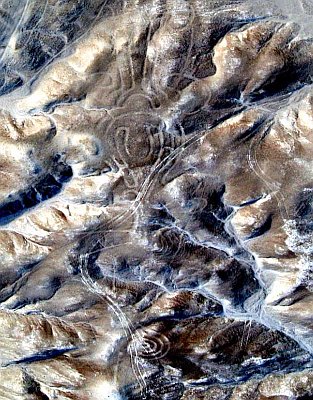 A new giant picture on the Nazca Plateau in Peru, which is famous for giant patterns that can be seen from the air, has been discovered by a team of Japanese researchers.
A new giant picture on the Nazca Plateau in Peru, which is famous for giant patterns that can be seen from the air, has been discovered by a team of Japanese researchers.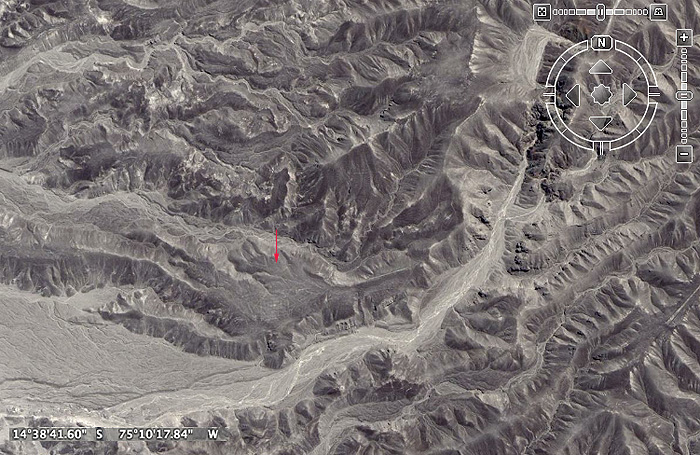
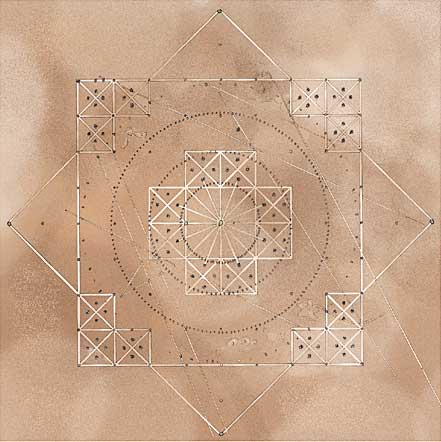 Gilbert de Jong -- A Nazcan Zodiac
Gilbert de Jong -- A Nazcan Zodiac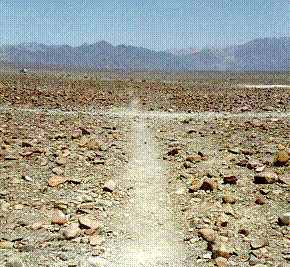
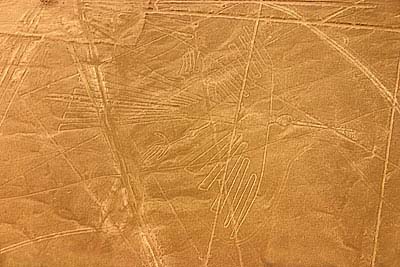
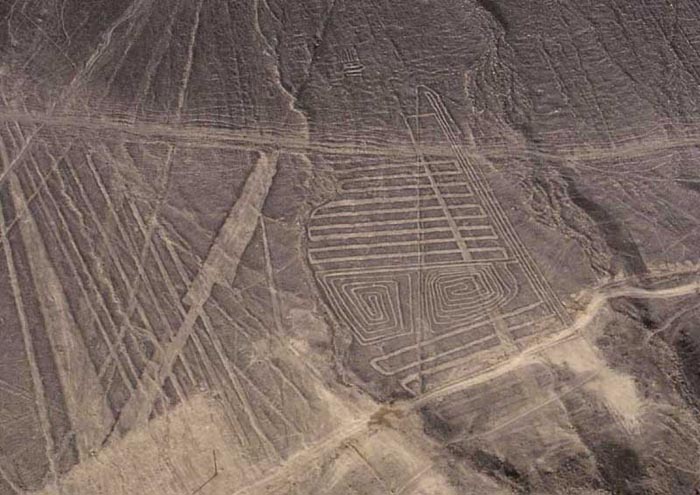
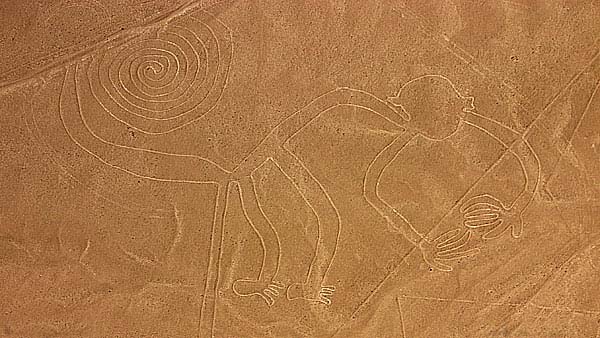 Robert Bast -- A memory of the Deluge
Robert Bast -- A memory of the Deluge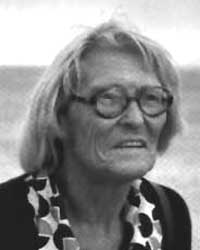 Maria Reiche -- Astronomical Theory
Maria Reiche -- Astronomical Theory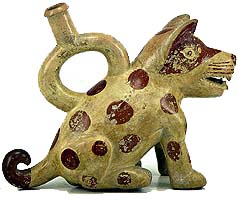
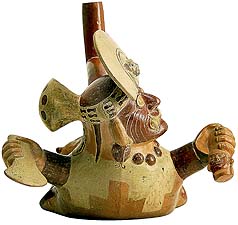
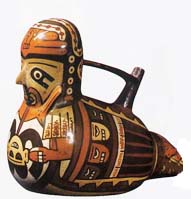
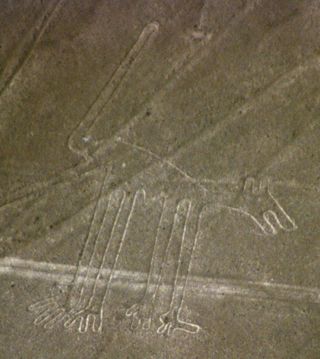
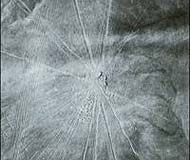 Anthony Aveni compares the Nazca lines with the ceque-lines [right] in Cuzco. Those lines were made in connection with a calendar, water and mountain deities. In this way the Nazca Indians celebrated a water-cult ritual. The figures and lines were used as paths for ceremonial dances.
Anthony Aveni compares the Nazca lines with the ceque-lines [right] in Cuzco. Those lines were made in connection with a calendar, water and mountain deities. In this way the Nazca Indians celebrated a water-cult ritual. The figures and lines were used as paths for ceremonial dances.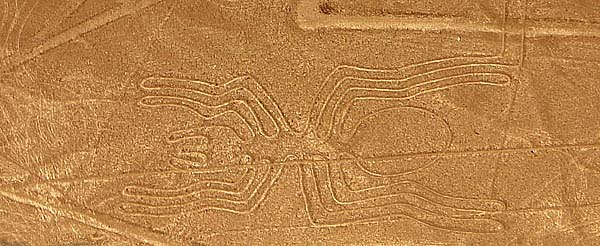
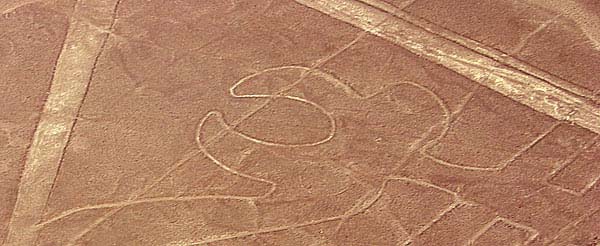
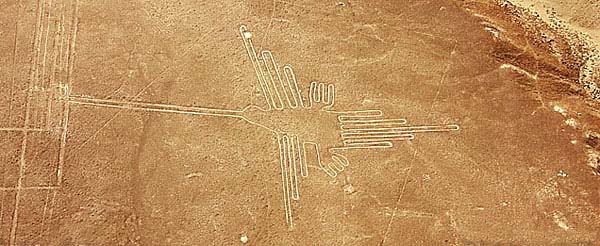
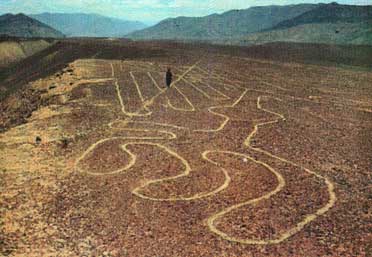 Albrecht Kottmann tried another approach to the Nazca-Mystery. He divided the figures into different parts and analyzed them in a geometrical way. So he divided a bird of 286 Meter length into 22 Parts. So he found that the head takes two parts, the neck five parts, the body three parts and the other twelve parts for the beak. The proportion between the beak and the rest is 6:5. Kottmann believes the geometric signs are a picture writing system with giant and small letters.
Albrecht Kottmann tried another approach to the Nazca-Mystery. He divided the figures into different parts and analyzed them in a geometrical way. So he divided a bird of 286 Meter length into 22 Parts. So he found that the head takes two parts, the neck five parts, the body three parts and the other twelve parts for the beak. The proportion between the beak and the rest is 6:5. Kottmann believes the geometric signs are a picture writing system with giant and small letters.


















.jpg)









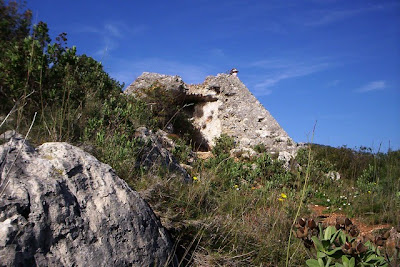



.jpg)


